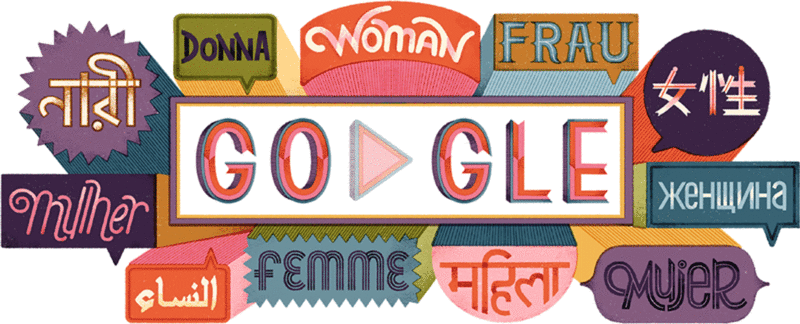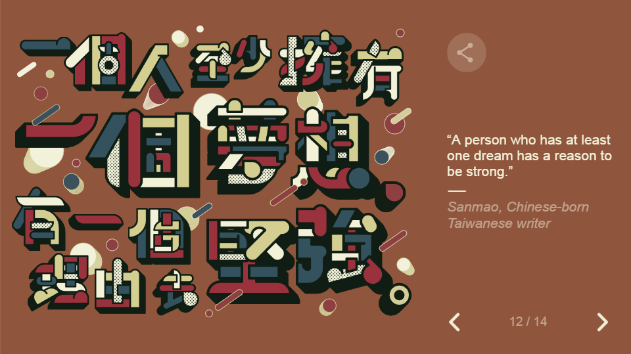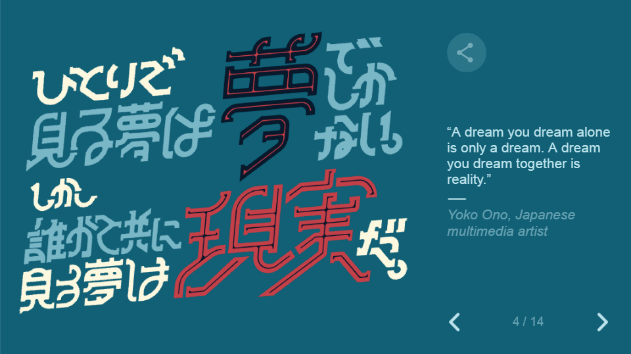Scripts in Google International Women's Day doodle
« previous post | next post »
For International Women's Day, Google made one of its doodles — this one with quotations from various women from around the world. Each is given its own distinctive typography. Several languages and scripts appear.
The ones with Hanzi / Kanji, however, are perhaps especially worthy of note, if only for how very different they are from how Mandarin and Japanese normally appear, even in decorative contexts.
Those two were illustrated by Japanese graphic designer Hazuki Tamano, according to this page.
I'm curious how well Japanese can read the Yoko Ono quote as presented.
[Thanks to Mark Swofford]



Gruen said,
March 9, 2019 @ 11:31 am
To my (mildly trained) eyes, the latter is eminently readable (although the る in the second 見る would be unrecognisable out of context), but the former is more laborious (particularly with the final 個). It's notable how in both examples the letterforms vary character to character, line to line, which made me second guess myself a couple of times.
Namae said,
March 9, 2019 @ 11:33 am
The Japanese quote is slightly difficult to read just because the order of the characters is not strictly linear, but the characters themselves are mostly easy to recognise. Some of the shapes are indeed very unusual, particularly of る in both instances of 見る, but the human brain easily compensates for this with contextual information.
unekdoud said,
March 9, 2019 @ 12:31 pm
I find the Mandarin hanzi a lot harder to read due to the visual noise and coloring breaking up the shapes, as well as tripping up on the grammar. Some of the typographical details there are really interesting.
Crystal said,
March 9, 2019 @ 3:39 pm
I’m not a native speaker of Japanese, but I had no problems reading the quote.
Bathrobe said,
March 9, 2019 @ 10:48 pm
I somehow managed to read the English as "Go Ogle". How sexist of me!
wikikali said,
March 9, 2019 @ 11:59 pm
The selection of colors for writing was very bad and difficult to read!
David Morris said,
March 10, 2019 @ 6:59 am
I know that French femme doubles up as 'woman' and 'wife' (though there are other possible words). In how many languages is there this doubling up? (Approximately.)
AZ said,
March 10, 2019 @ 7:37 am
I’m a native Russian speaker and I had a hard time reading the Russian, honestly.
Brandon Berg said,
March 10, 2019 @ 11:23 am
Non-native, but I found the Japanese one mostly easily legible. The only one that threw me for a loop was 誰かと共に, because the と looks more like て.
Joke Kalisvaart said,
March 10, 2019 @ 4:30 pm
@Davis Morris: The same in Dutch. The Dutch word 'vrouw' is used for both 'woman' and 'wife'.
KeithB said,
March 11, 2019 @ 8:46 am
This reminds me of the calligraphy Don Knuth commissioned for his
"3:16 Bible Text illuminated" book.
Google that and "calligraphy" and you can see some examples.
Andreas Johansson said,
March 12, 2019 @ 6:37 am
@Bathrobe
When I first encountered Google way back when, I did wonder if "go ogle" was the etymology.
@David Morris:
German also combines "woman" and "wife" as Frau.
Possibly interestingly, in Swedish man is both "man" and "husband", but there's no similar syncretism between "woman" (kvinna) and "wife" (fru).